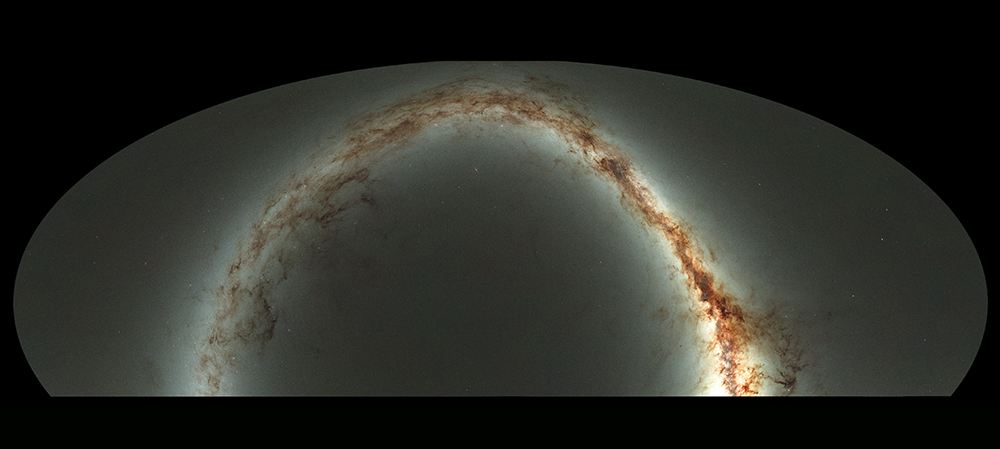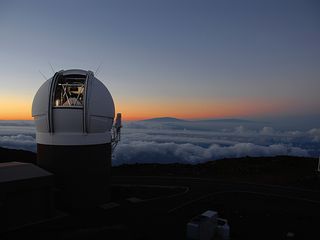A Cosmic Wikipedia: Massive Digital Sky Survey Is Unveiled for Scientists

Call it a cosmic Wikipedia: A massive catalog of astronomical data collected over four years using one of the largest digital cameras ever built is now available to scientists around the world.
The Panoramic Survey Telescope & Rapid Response System, or Pan-STARRS, began observing the night sky in 2010, using a 1.8-meter telescope at the summit of Haleakala, on the island of Maui in Hawaii. In four years, the telescope scanned about three-quarters of the visible sky 12 times (using five different light filters), gradually registering about 3 billion unique objects, according to the project collaborators.
The newly released catalog is the world's largest digital sky survey to date, according to a statement from the University of Hawaii Institute of Astronomy, the project's headquarters. The catalog consists of 2 petabytes of data (2 million gigabytes), which is about 100 times the total content of Wikipedia. In addition to making the data freely available, the project collaborators have spent years making the catalog easy for other scientists to use. [The 100BestSpace Photos of 2016]
One of the key objectives of Pan-STARRS (and of many other survey projects) is to look for short-term changes in the night sky. By comparing the images of the same section of the sky taken on different dates (or over multiple dates), scientists can look for small changes, such as objects moving or changing in brightness. With this method, Pan-STARRS has already helped identify a new comet and multiple near-Earth asteroids. (Pan-STARRS set a record by finding 19 new asteroids in a single night).
A zoo of cosmic objects

This data set (which is being called the Pan-STARRS1 Surveys) can be used in an incredibly wide range of applications, partly because of the variety of objects it has identified. Those objects include stars, galaxies, asteroids, objects in the Kuiper Belt (the outer region of the solar system that includes Pluto), planets around other stars, gas clouds, quasars (massive galaxies in the early universe with monster black holes at their centers), the remains of stellar explosions, white dwarfs (nuggets of hot material left over after some stars die), and brown dwarfs (stars that haven't achieved fusion and ignited).
Get the Space.com Newsletter
Breaking space news, the latest updates on rocket launches, skywatching events and more!
The time variability of the Pan-STARRS data also opens many different doors for astronomers —in addition to identifying moving asteroids and objects in the Kuiper Belt, the temporal aspect of the data lets scientists observe the general movement of various objects, and in some cases makes it possible to create a 3D view of a region of the sky.
"Pan-STARRS also has given us an unprecedented view of the dynamic and transient nature of astronomical phenomena," Edo Berger, an astronomer at the Harvard-Smithsonian Center for Astrophysics, another collaborating institution, said in the same statement. "Our group discovered and studied new types of supernova explosions and the disruptions of stars by supermassive black holes from the Pan-STARRS data."
The Pan-STARRS collaboration includes 10 research institutions in four countries, with support from NASA and the National Science Foundation (NSF). A joint statement from the Max Planck Institute for Astronomy in Heidelberg, Germany, and the Max Planck Institute for Extraterrestrial Physics in Garching, Germany, (two of the collaborating institutions) praised other science opportunities that have arisen from Pan-STARRS. Those include a census of stars, brown dwarfs and white dwarfs extending to distances of "about 300 light-years" from Earth's sun, and profiles of the light coming from "about 4 million Jupiter-like planets" orbiting closely around relatively cool stars known as red dwarfs. Scientists have used Pan-STARRS data to study dark matter in the Andromeda galaxy, and map the stars and dust in the Milky Way "to a level of detail never achieved before."
In addition to collecting all that data, the Pan-STARRS collaborators have spent the last few years making it easy to use.
"For the past three years, we put much effort into checking the quality of the data and defining the most useful structure for the catalogue," Roberto Saglia, who led the Pan-STARRS participation at the Max Planck Institute for Extraterrestrial Physics, said in the statement. "We … thought a lot about how best to combine the individual observations and how to present the relevant information for each type of objects."
The catalog's data is being released in two separate parts; the first part is called the "Static Sky," and provides a map of the sky that is averaged over the telescope's 12 scans of the sky. In 2017, a second data set will be released, containing data from each individual scan of the sky.
Editor's Note: This article previously stated that the Pan-STARRS catalogue consisted of 2 billion petabytes of data; it consists of 2 petabytes.
Follow Calla Cofield @callacofield.Follow us @Spacedotcom, Facebook and Google+. Original article on Space.com.
Join our Space Forums to keep talking space on the latest missions, night sky and more! And if you have a news tip, correction or comment, let us know at: community@space.com.

Calla Cofield joined Space.com's crew in October 2014. She enjoys writing about black holes, exploding stars, ripples in space-time, science in comic books, and all the mysteries of the cosmos. Prior to joining Space.com Calla worked as a freelance writer, with her work appearing in APS News, Symmetry magazine, Scientific American, Nature News, Physics World, and others. From 2010 to 2014 she was a producer for The Physics Central Podcast. Previously, Calla worked at the American Museum of Natural History in New York City (hands down the best office building ever) and SLAC National Accelerator Laboratory in California. Calla studied physics at the University of Massachusetts, Amherst and is originally from Sandy, Utah. In 2018, Calla left Space.com to join NASA's Jet Propulsion Laboratory media team where she oversees astronomy, physics, exoplanets and the Cold Atom Lab mission. She has been underground at three of the largest particle accelerators in the world and would really like to know what the heck dark matter is. Contact Calla via: E-Mail – Twitter